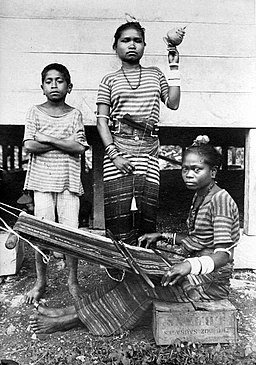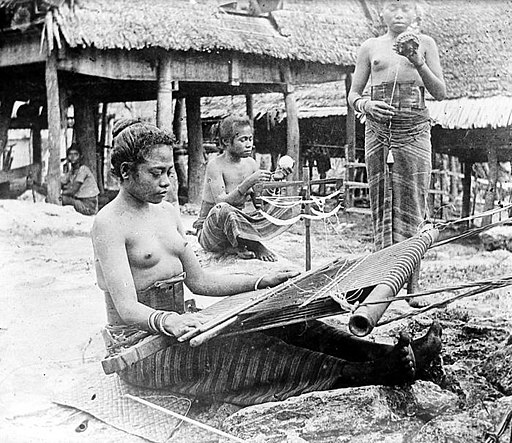Loom Design/Loomates/Indonesia
Indonesian islands: Sumatra | Borneo | Sulawesi | Java | Bali | Lombok | Flores | Sumba | Sumbawa | Timor | Tanimbar
Ethnic groups: Batak | Palembang | Kanekes/Baduy | Javanese | Sundanese | Banjuwang | Sikka | Ngada | Morro
Loom Types: Stake Loom | Station Loom | Gamelan | Crawl Loom |
Watch Mac & Magic's playlist on youTube:
Indonesische Weberin an einer Hüftwebstation, 1880-1920 (Tropenmuseum - wikimedia)
Loin Looms of Sumatra
Regions: | Palembang | Aceh | Minangkabau
Ethnic groups: | Batak
>> Loin Looms of Sumatra - backstrap weaving
Watch Mac & Magic's playlist on youTube:
Batak people
Most Batak people are located around Lake Toba on Northern Sumatra. Their backstrap loom is a kind of verandah loom, what means its warp beam gets connected with some hanging ropes to the pillars on the verandah of their stilt hut. In most cases you may find them weaving, sitting in front of the house, but also on the verandah or even under the stilt house. They use a circular warp and no reed comb, what is actually not in tune with the mainstream of Sumatra nowadays, using flat warp and a reed comb. So it seems to be one of the last models left on Sumatra working still with the authentic circular warp for Austronesian loin looms. But as most of the loin loom cultures of Indonesia this loom uses a yoke to improve tension for wide warps and it has that typical Indonesian batten rest table.
Scientifically this loom belongs to loom-category [B] Externally-braced, body-tensioned handlooms with a circular warp. For our purpose we group it on top to [2] Stake looms. But here we have a great example of an eventually archaic pre-type of stilt loom. The same use of the house stilts, as we can observe with the Karen people in Myanmar. So this may be another proof of a theory, that stilt looms had been spread all over the mainland of Southeast Asia; from Northeast-India to the Southern islands. In this case, it shows out again, that the subgroup of verandah looms didn't come up from tree looms. So they wouldn't fit into the group of stake looms, where we sort them in right now. This shows out for what purpose we invented the loin loom grouping system; not to define, what it is, but to get a closer definition of how it may have been developed.
>> Loin Looms of Batak People - backstrap weaving
Loom category: [B] Externally-braced, body-tensioned handlooms with a circular warp
Loin loom group: stake loom (stilt loom?): subgroup: verandah loom
warp type: circular warp
- Jasper
Watch Mac & Magic's playlist on youTube:
Loin Looms of Sangiree
The loin looms of Sangir Island, an archipelago of Northern Sulawesi work with a circular warp. Sangir is already the half way to the Philippines. Most of the Austronesian groups took that way to migrate from Taiwan (old theory!; now: Chinese mainland) via the Philippines to the Indonesian islands since 1.000 BCE. This is the reason this simple loom of that tiny island is mentioned as THE contemporary witness of this migration era. It's popular on Sangir to arrange the loom in the door gate of the house, a habit we can also observe on the Pacific islands (Koshrae). The method to fixate the foot-brace by a backwards led rope is similar to some methods on the Philippines. Maybe due to the narrow warp there is no yoke, that's so typical for most Indonesian looms. Even the half way diagonally leading of the warp reminds the Philippines.
Jasper
Ethnic group: Sangiree (Austronesian) - Sangir, Indonesia
Loom category: [B] Externally-braced, body-tensioned handlooms with a circular warp
Loin loom group: stake loom; subgroup: gate loom/verandah loom
warp type: circular warp
Loin Looms of Sulawesi
Ethnic groups: | Toraja | Morro
Looms: | Gorontalo
>> Loin Looms of Sulawesi - backstrap weaving
Watch Mac & Magic's Loomates-playlist on youTube:
Loin Looms of Borneo (Kalimantan)
Dayak is a term, that just collects just all cultural tribes of Borneo Island, but it's no tribe on its own! The loin loom of Dayaks uses a reed to manage the width-holding, but no reed-comb to beat-in is in play; just a standard batten sword to beat-in the weft. This reed replaces the use lease-sticks. But in front of and after this lease-reed there is each a coil rod inserted! The spliced breast beam reminds very much that of Filipino looms. And even here we can't spot any Indonesian-type yoke. Same as we observe with the simple looms on Sangir island, just a simple hip belt is used for body-tensioning. The differences between Borneo looms and looms on Java may be another witness of the migration routes of Austronesian people from the Philippines via Northern Sulawesi to Borneo in the first era.
But let's keep in mind: Next to the migration of Austronesian people, it seems, there was a migration by Austro-asiatic people onto Sumatra and Borneo from the Malaysian peninsula. Maybe this happened before Austronesian tribes reached Borneo. We should be aware about, that even these Austro-asiatic groups were assimilated by Austronesian culture, some fragments might have had a rare influence.
Components of the Dayak Loom (11): warp beam, coil rod 1 (in front of lease-reed), lease-reed comb, coil rod 2 (after the lease-reed), shed roll, heddle bar, small spool stick, big spool stick, batten sword, spliced breast beam, hip belt.
>> Loin Looms on Borneo - backstrap weaving
- Jasper
Ethnic group: Dayak | Iban | Kenyah - (Austronesian) - Borneo, Indonesia
Loom category: [B] Externally-braced, body-tensioned handlooms with a circular warp
Loin loom group: stake loom
warp type: circular warp
Watch Mac & Magic's Loomates-playlist on youTube:
Loin Looms of Java
Ethnic groups: | Sundanese | Kanekes/Baduy | Javanese | Madurese | Banjuwangi
Loom types: | station loom | stilt loom | gamelan
There are several ethnic groups on Java, each a different techniques of weaving. In general most traditional backstrap looms on Java are of this typical Indonesian style of weaving stations with ist batten rest tables. It seems these typical Indonesian weaving station type was once invented or developed on Java and spread from here to neighbouring islands (Sumatra, Bali, Lombok). But in most cases no ethnic group on Java works still with a plain stake loom. We may find stilt looms like the Kanekes people, a part of the Sundanese people, in West-Java. Basically we can differ Sundanese looms from Javanese by the way, how its flat warp is wound around its warp board (down under/above). Some ethnic groups on Java use a kind of smaller stilts (quarter stilts) or an advanced type of quarter-stilts. The very most of backstrap looms on Java use the flat warp,
>> Loin Looms of Java - backstrap weaving
Watch Mac & Magic's Loomates-playlist on youTube:
Loin Looms of Bali
Most of loin looms on Bali come as a type of station Loom in typical Indonesian manner with a batten rest. There are several techniques using these weaving stations on a plain style sitting on the ground, a podestry, or even lifted up by some bricks with the warp in a diagonal manner.
>> Loin Looms on Bali - backstrap weaving
Watch Mac & Magic's Loomates-playlist on youTube:
Loin Looms of Lombok
Also on Lombok island you find the typical Indonesian type of weaving stations used for backstrap weaving. Even there is no great difference in the functions, the appearance of weaving stations on Lombok is slightly different to Balinese or most weaving stations on Java. First at all their rails appear much longer and heavier. They are placed on a podestry with their crawls resting on the edge of the podestry. Their warp board supporting stilts tend to a diagonal position. The warp is led down under the warp board, like the Sundanese style..
Watch Mac & Magic's Loomates-playlist on youTube:
Loin Looms of Flores
The loin loom of the Sikka people on Flores Island is a perfect example of a stake loom-type. The Sikka weave very flat and horizontal to the ground, called a ground loom. As the length of their warps are usually quiet long (maybe about 4-5 m long circular warp), they like to use two further stakes, driven into the ground at the heights of their feet, to stop their foot-brace at! They don't use a reed comb, just the batten sword to beat-in the weft. But there are also other ethnic groups on Flores!
>> Loin Looms on Flores - backstrap weaving
Watch Mac & Magic's Loomates-playlist on youTube:
Sikka-Weberinnen an ihren typischen angepflockten, flachen Bodenwebstühlen mit Rundkette, Ost-Flores, ca. 1915
(Le Roux - wikimedia)
Bildquelle:
Tropenmuseum - Le Roux: Weefsters met weeftoestellen, Sikka, Oost-Flores, ca. 1915 - https://hdl.handle.net/20.500.11840/7808
Loin Looms of Sumba
Loin looms on Sumba island use a circular warp. In many cases the loom gets fixated to the ceiling of the house on the verandah. We may also find people weaving in the yard. Their circular warp is about 4 m long; the foot-brace is managed by an extension against the wall. There is no use of a reed comb, but the typical Indonesian wooden yoke. We may observe weavers seated on a wooden board, a very rare thing amongst loin looms, but quietly recommended to release the muscles of the lower stomach! The warp is quietly horizontal led with a slight lifting tendency. The way how the height of the warp beam is supported by two diagonal bamboo cane rails reminds very much the Champa Station Loom of Central Vietnam.
Weberin mit einem Hüftwebstuhl in Waingapu auf Ost-Sumba, März 1949 (Tropenmuseum - wikimedia)
Bildquelle:
- Tropenmuseum - Taillie: Weefster achter een weeftoetsel, Waingapu, Sumba Timur, 01.03.1949 - https://hdl.handle.net/20.500.11840/307198
Ethnic group: ... (Austronesian) - Sumba, Indonesia
Loom category: [B] Externally-braced, body-tensioned handlooms with a circular warp
Loin loom group: stake loom; subgroup: verandah loom/yard loom
warp type: circular warp
Watch Mac & Magic's Loomates-playlist on youTube:
Loin Looms of Sumbawa
Weberinnen mit Hüftwebstuhl auf der Insel Sangéang
(nördlich von Sumbawa, 1900-1940 (Tropenmuseum - wikimedia)
Loin Looms on Timor
Loin looms on Timor island ........
>> Loin Looms on Timor - backstrap weaving
Ethnic group: ... (Austronesian) - Timor, Indonesia
Loom category: [B] Externally-braced, body-tensioned handlooms with a circular warp
Loin loom group: stake loom; subgroup: yard loom
warp type: circular warp (?)
Loin Looms on Tanimbar
Loin looms on Tanimbar island ........
Eine Spinnerin & eine Weberin an einem Hüftwebstuhl auf Tanimbar, 20. Jhd.?
(Tropenmuseum - wikimedia)
Bildquelle:
- Tropenmuseum - anonymous: Een weefster, een spinster en een jongen, Tanimbar-eilanden - https://hdl.handle.net/20.500.11840/214616
Ethnic group: ... (Austronesian) - Tanimbar, Indonesia
Loom category: [B] Externally-braced, body-tensioned handlooms with a circular warp
Loin loom group: stake loom
warp type: circular warp
Zwei Spinnerinnen & eine Weberin an einem Hüftwebstuhl auf Tanimbar (Molukken), 1900-1940
(Tropenmuseum - wikimedia)
Bildquelle:
- Tropenmuseum - anonymous: Weefster en draadspinster, Tanimbar eilanden, Molukken - https://hdl.handle.net/20.500.11840/232038
Appendix
Loin Looms of Papua (Irian Jayah, East Indonesia)
Sobei Foot Loom
The foot loom of Sobei has kept its unique simple design into the present time. Science states, that these are rebuilds of externally-braced & externally-tensioned "loin loom". That means, these models didn't migrate from the Chinese mainland. Anyway this foot loom is a seldom thing. Not very much in daily use nowadays, it appears as a kind of teaching loom for kids and beginners.
So there are three different kind of this simple looms in one community:
- a simple foot loom
- an externally-braced stake loom-type
- a rare model of a frame-supported loin loom-type.


























Write a comment